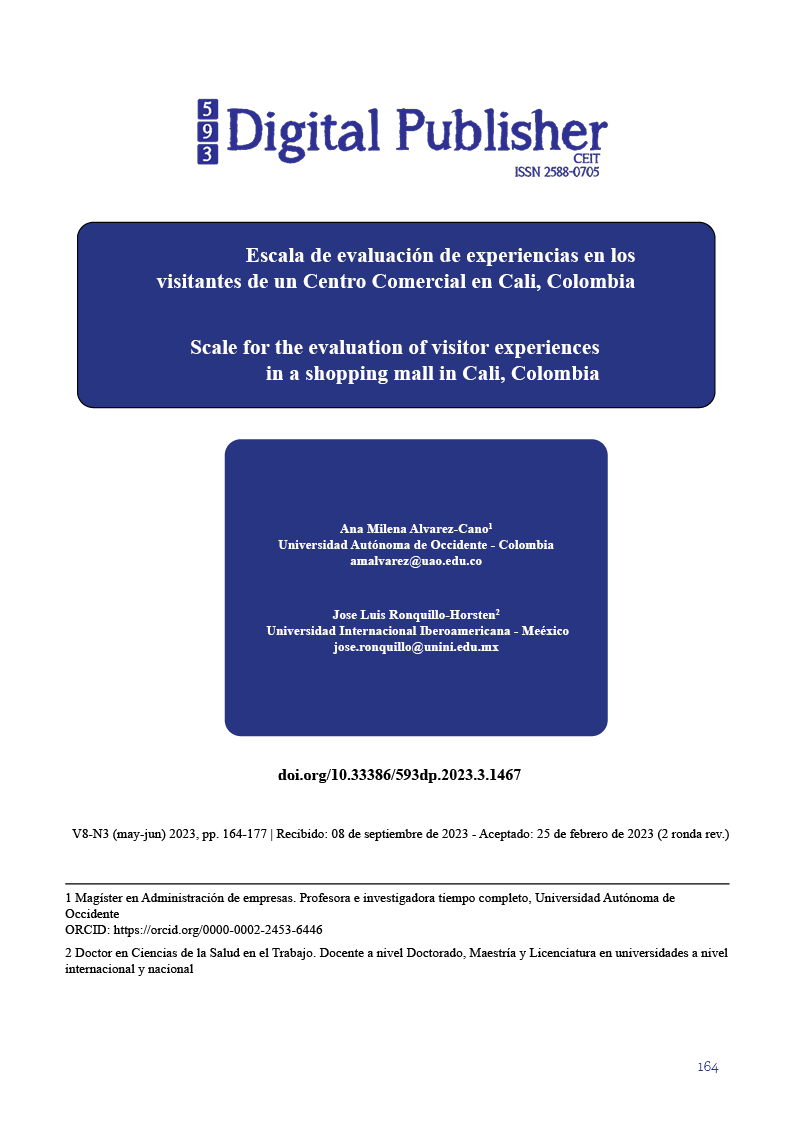Scale for the evaluation of visitor experiences in a shopping mall in Cali, Colombia
Main Article Content
Abstract
This article presents the reliability and validity of a scale that evaluates the experiences of visitors to the shopping center in Cali - Colombia. The methodology is framed within a quantitative, descriptive and causal approach, through the application of the hypothetical-deductive method. The variables considered in the measurement scale were determined from a theoretical review and content validation. To collect the information, a personal survey was administered to a sample of 343 customers. The validity and reliability of the scale was determined by Exploratory Factor Analysis, Cronbach's coefficient and Confirmatory Factor Analysis. Among the main findings, it is highlighted that the scale shows high reliability and internal consistency since one factor explains 50% of the total accumulated variance and the total Cronbach's Alpha is 0.846. When the confirmatory model was applied, positive correlations were identified between the indicators and the variables and between the three variables. Therefore, the final scale consisted of three subscales and 23 items.
Downloads
Article Details

This work is licensed under a Creative Commons Attribution-NonCommercial-ShareAlike 4.0 International License.
1. Derechos de autor
Las obras que se publican en 593 Digital Publisher CEIT están sujetas a los siguientes términos:
1.1. 593 Digital Publisher CEIT, conserva los derechos patrimoniales (copyright) de las obras publicadas, favorece y permite la reutilización de las mismas bajo la licencia Licencia Creative Commons 4.0 de Reconocimiento-NoComercial-CompartirIgual 4.0, por lo cual se pueden copiar, usar, difundir, transmitir y exponer públicamente, siempre que:
1.1.a. Se cite la autoría y fuente original de su publicación (revista, editorial, URL).
1.1.b. No se usen para fines comerciales u onerosos.
1.1.c. Se mencione la existencia y especificaciones de esta licencia de uso.
References
Álvarez del Blanco, R. (2011). Branding hoy: estrategias que funcionan. Marca multisensorial, espléndidamente lúcida. Harvard Deusto Marketing y Ventas, 106, 26–33. Retrieved from https://dialnet.unirioja.es/metricas/documentos/ARTREV/3720150
Avello, M., Gavilan, D., Abril, C. y Manzano, R. (2011). Experiential shopping at the mall: influence on consumer behaviour. China-USA Business Review, 10 (1), 16-24. https://www.researchgate.net/profile/Diana-Gavilan-2/publication/275350817_Experiential_shopping_at_the_mal_Influence_on_Consumer_Behavior/links/553de9090cf29b5ee4bce8e2
Bagozzi, R.P. y Yi, Y. (2012). Specification, evaluation, and interpretation of structural equation models. Journal of the academy of marketing science (40), 8–34. https://doi.org/10.1007/s11747-011-0278-x
Barreiro, J. M., López, M. Á., Losada, F. y Ruzo, E. (2002). Análisis de las dimensiones cognoscitiva y afectiva del comportamiento ecológico del consumidor. Revista Galega de Economía, 11(2), 1–21. https://www.redalyc.org/articulo.oa?id=39111205
Bentler, P. M. (1990). Comparative fit indexes in structural models. Psychological Bulletin, 107(2), 238–246. https://doi.org/10.1037/0033-2909.107.2.238
Bentler, P. M. y Bonett, D. G. (1980). Significance tests and goodness-of-fit in the analysis of covariance structures. Psychological Bulletin, 88, 588-606. http://dx.doi.org/10.1037/0033-2909.88.3.588
Bilgicer, T., Jedidi, K., Lehmann, D. R. y Neslin, S. A. (2015). Contagio social y adopción por parte de los clientes de nuevos canales de venta. Journal of Retailing, 91(2), 254-271.https://doi.org/10.1016/j.jretai.2014.12.006.
Bitner, M. (1992). Servicescapes: The Impact of Physical Surroundings on Customers and Employees. Journal of Marketing, 56, 57–71. https://doi.org/10.2307/1252042
Bowman, C. H. y Fishbein, M. (1978). Understanding public reaction to energy proposals: An application of the Fishbein Model 1. Journal of Applied Social Psychology, 8(4), 319-340. https://doi.org/10.1111/j.1559-1816.1978.tb00787.x
Canter, D. V. y Craik, K. H. (1981). Environmental psychology. Journal of Environmental Psychology, 1(1), 1–11. https://doi.org/10.1016/S0272-4944(81)80013-8
Cerda, L. M. (2002). Tipología y evolución de los Centros comerciales. Revista y Distribución y Consumo, 66 (12), 43-60. https://dialnet.unirioja.es/servlet/articulo?codigo=299014
Cornejo, I. (2006). El centro comercial: ¿una nueva forma de "estar juntos"? Cultura y representaciones sociales, 1(1), 93-127. http://www.scielo.org.mx/scielo.php?script=sci_arttext&pid=S2007-81102006000100004&lng=es&nrm=iso
Cuesta, P. (1999). Centros Comerciales en España. Revista Distribución y Consumo, 48 (9), 5-26. https://www.researchgate.net/publication/47341503_El_equipamiento_comercial_de_los_centros_comerciales_en_Espana
De Juan Vigaray, M. D. (1994). Comercializacion y Retailing Distribución Comercial Aplicada. (P. H. Iberia, Ed.). España.
Dong, P. y Siu, N. Y. M. (2013). Elementos de servicios, predisposiciones del cliente y experiencia en el servicio: el caso de los visitantes de los parques temáticos. Gestión del turismo, 36, 541–551. https://www.scholars.northwestern.edu/en/publications/servicescape-elements-customer-predispositions-and-service-experi-2
Elmashhara, M. G. y Soares, A. M. (2019). The impact of entertainment and social interaction with salespeople on mall shopper satisfaction: The mediating role of emotional states. International Journal of Retail & Distribution Management. www.emeraldinsight.com/0959-0552.htm
Vilnai-Yavetz, I., Gilboa, S. y Mitchell, V., (2021). Experiencing atmospherics: The moderating effect of mall experiences on the impact of individual store atmospherics on spending behavior and mall loyalty. Journal of Retailing and Consumer Services, Elsevier, vol. 63(C). DOI: 10.1016/j.jretconser.2021.102704
Hernandez, I., Hernández J. y Hernández, R. (2013). Los centros comerciales el nuevo paradigma de. Revista de pesquisa en arquitectura e urbanismo, 17, 35–47. https://xdoc.mx/preview/los-centros-comerciales-el-nuevo-paradigma-de-iau-5eb477ef7ecb5
Holadan C. J. (1991). Psicología ambiental, un enfoque general. Lumusa.
Holbrook, M. B. y Hirschman, E. C. (1982). The Experiential Aspects of Consumption: Consumer Fantasies, Feeiings, and Fun. Journal of Consumer Research, 9(September), 132–141. https://doi.org/10.1086 / 208906
Hu, H. y Jasper, C. R. (2015). El impacto de la experiencia de compra del consumidor en la decisión del canal del consumidor. Academy of Marketing Studies Journal, 19(1), 213. https://www.proquest.com/openview/ee31f3bd885f18b23a9421fb0ebaf7a8/1?cbl=38744&pq-origsite=gscholar&parentSessionId=ML0yA14%2BAZEIE71wa1N5dbWNeDu5kLDWvxq91uYw9Aw%3D
Hultén, B. (2011). Sensory marketing: the multi‐sensory brand‐experience concept. European Business Review, Vol. 23 No. 3, pp. 256-273. https://doi.org/10.1108/09555341111130245
Ittelson, W. H., Franck, K. A. y O’Hanlon, T. J. (1976). The nature of environmental experience. Experiencing the environment, Springer, Boston, MA, 186–206. DOI: 10.1007/978-1-4613-4259-5_9
Kesari, B. y Atulkar, S. (2016). Satisfaction of mall shoppers: A study on perceived utilitarian and hedonic shopping values. Journal of Retailing and Consumer services, 31(1), 21–31. https://doi.org/10.1016/j.jretconser.2016.03.005
Kotler, P. (1973). Atmospherics as a marketing tool. Journal of Retailing. Journal of Retailing, 49(4). http://belzludovic.free.fr/nolwenn/Kotler%20-%20Atmospherics%20as%20a%20marketing%20tool%20%20(cit%C3%A9%20171)%20-%201973.pdf
Kwon, H., Ha, S. y Im, H. (2016). El impacto de la similitud percibida con otros clientes en la satisfacción del centro comercial. Journal of Retailing and Consumer Services, 28, 304–309. https://doi.org/10.1016/j.jretcons
Lazarus, R. S. (1982). Thoughts on the relations between emotion and cognition. American Psychologist, 37(9), 1019–1024. https://doi.org/10.1037/0003-066X.37.9.1019
Lovelock C. H. y Wirtz J. (2016). Marketing de servicios: personas, tecnologías, estrategias. (7a ed.). México: Pearson.
Malhotra, N. (2008). Investigación de mercados. (5a ed.). México: Pearson Prentice hall
Martínez-Tur, V., Zurriaga, R., Luque, O., y Moliner, C. (2005). Efecto modulador del tipo de segmento en la predicción de la satisfacción del consumidor. Psicothema, 17(Número 2), 281-285. https://reunido.uniovi.es/index.php/PST/article/view/8269
Mattsson, J., Lemmink J. y McColl R. (2004) The Effect of Verbalized Emotions on Loyalty in Written Complaints, Total Quality Management & Business Excellence, 15:7, 941-958, DOI: 10.1080/14783360410001681890
McIver, J., y Carmines, E. G. (1981). Unidimensional scaling (Vol. 24). Sage.
Meyer, C. y Schwager, A. (2007). Understanding Customer Experience. Harvard Business Review, 85(2). https://idcexed.com/wp-content/uploads/2021/01/Understanding_Customer_Experience.pdf
Muñoz, M., Fernández, J. y Sánchez, F. (2019). Comportamiento de compra racional e impulsiva de los jóvenes estudiantes en los centros comerciales. Revista Academia y Negocios, 5 (1), 61-70. https://papers.ssrn.com/sol3/papers.cfm?abstract_id=3432081
Páramo, C. V. H. (2013). Imagen de los centros comerciales: su análisis urbano y económico. Urbano, 68-74. http://revistas.ubiobio.cl/index.php/RU/article/view/731/693
Pérez, R., Polo, Y., y Palacios, L. (2016). La influencia de los Variables sociales en la experiencia del cliente: un análisis de efectos de interacción (Tesis doctoral). España: Universidad de Zaragoza. https://zaguan.unizar.es/record/57882
Price, L. L., Arnould, E. J. y Deibler, S. L. (1995). La influencia del proveedor del servicio. International Journal of Service Industry Management, 66(3), 34–63. https://www.emerald.com/insight/content/doi/10.1108/09564239510091330/full/html
Purani, K. y Kumar, DS. (2018). Explorando el potencial restaurador de los paisajes de servicios biofílicos. Revista de Marketing de Servicios, 32 (4), 414-429. https://doi.org/10.1108/JSM-03-2017-0101
Sarafoleanu, C., Mella, C., Georgescu, M. y Perederco, C. (2009). The importance of the olfactory sense in the human behavior and evolution. Journal of medicine and life, 2(2), 196. https://www.ncbi.nlm.nih.gov/pmc/articles/PMC3018978/
Schmitt, B. H. (1999). Marketing experiencial: cómo hacer que los clientes identifiquen en su marca: sensaciones, sentimientos, pensamientos, actuaciones y relaciones. Barcelona: Deusto.
Schumacker, R. E., y Lomax, R. G. (2004). A beginner's guide to structural equation modeling. Publishers mahwah, New Jersey London
Singh, H. y Prashar, S. (2014). Anatomía de la experiencia de compra de centros comerciales en Mumbai: un enfoque de análisis factorial confirmatorio. Journal of Retailing and Consumer Services, 21(2), 220–228. https://doi.org/10.1016/j.jretconser.2013.08.002
Tifferet, S., y Vilnai-Yavetz, I. (2017). Phytophilia and service atmospherics: the effect of indoor plants on consumers. Environment and Behavior, 49(7), 814-844. https://doi.org/10.1177/0013916516669390
Turley, L.W. and Milliman, R.E. (2000) Atmospheric Effects on Shopping Behavior: A Review of the Experimental Evidence. Journal of Business Research, 49, 193-211.
http://dx.doi.org/10.1016/S0148-2963 (99)00010-7
Verhoef, P.C., Lemon, K. N., Parasuraman, A., Roggeveen, A., Tsiros, M. y Schlesinger, L. A. (2009). Customer Experience Creation: Determinants, Dynamics and Management Strategies. Journal of retailing, 85(1), 31-41. https://doi,org/10.1016/j.jretai.2008.11.001
Vilnai-Yavetz, I., Gilboa, S. y Mitchell, V., (2021). "Experiencing atmospherics: The moderating effect of mall experiences on the impact of individual store atmospherics on spending behavior and mall loyalty," Journal of Retailing and Consumer Services, Elsevier, vol. 63(C). DOI: 10.1016/j.jretconser.2021.102704
Williams, R. y Dargel, M. (2004). From servicescape to “cyberscape”", Marketing Intelligence & Planning, 22 (3), 310-320. http://dx.doi.org/10.1108/02634500410536894
Wirtz, J., Mattila, A.S. y Tan, R. L. (2000). El papel moderador de la activación de objetivos sobre el impacto del afecto en la satisfacción: un examen en el contexto de las experiencias de servicio. Journal of Retailing, 76(3), 347–365. https://doi.org/10.1016/S0022-4359(00)00031-2
Zampini, M. y Spence, C. (2005). Modificación de la percepción multisensorial de una bebida carbonatada utilizando señales auditivas. Calidad y preferencia de los alimentos, 16(7), 632–641. https://doi.org/10.3758/BF03193329



